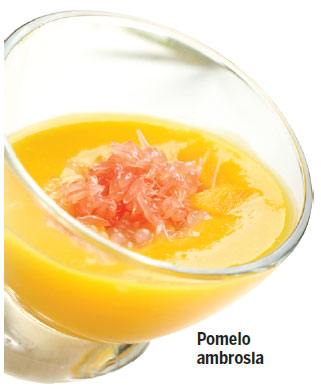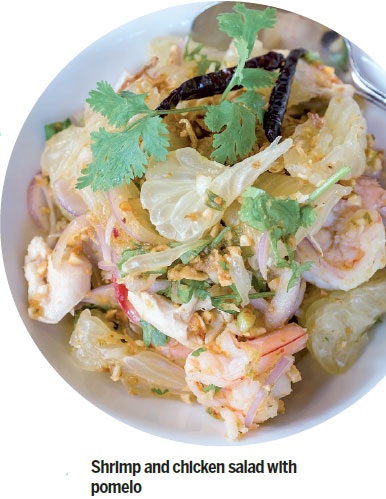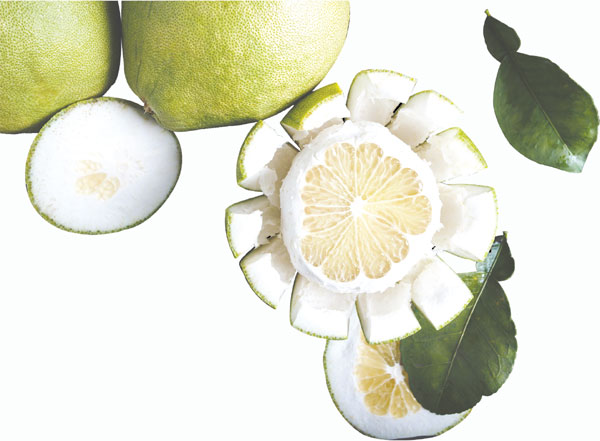Celebrating the Mid-Autumn moon
Editor's Note: Traditional and fusion cooking styles, regional and international ingredients and a new awareness of healthy eating are all factors contributing to an exciting time for Chinese cuisine. We explore the possibilities.
In a few days, Chinese communities everywhere will be celebrating Mid-Autumn Festival. It is one of the three major festivals of the Chinese almanac when families will try their best to get home for a reunion, the other two being Winter Solstice and Spring Festival.
On this day, the family will have dinner together, then set up a table in the garden or on the balcony, where they can enjoy the brightest, roundest moon of the year.
|
Pomelos are a must on the Mid-Autumn Festival. Photos Provided To China Daily |
On the table will be mooncakes stuffed with lotus or red bean paste, always with a whole salted egg yolk in them to remind folks of the moon. Sometimes there will be melon seeds or olive kernels studded around the yolk like stars.
Little purple taros or yams will be piled on a plate, waiting to be peeled and dipped into a saucer of sparkling granulated sugar.
Another seasonal delicacy will be water caltrops, the strange aquatic fruit of a pretty pond plant. They have fearsome-looking black horns and resemble a miniature buffalo's head, but their snowy white insides are nutty and delicious.
But the centerpiece on our family table has always been a huge pomelo, gleaming golden like the moon and faintly scented with a sweet, citrusy tang.
A week or so before, my grandfather would have sent word to his favorite fruit stall. They were to find the largest, sweetest pomelo for him. The best were always from Shatian in the Guangxi Zhuang autonomous region, and the fruit would be imported by the basket, then displayed in little mountains that dominated the storefronts.
A very Asian fruit - many Westerners might not have seen one before, let alone eaten one - the pomelo is like a giant grapefruit, with thick, fleshy rinds that are peeled back to expose tightly packed segments of pale, creamy yellow or pink flesh.

Unlike most other citrus fruits, the flesh of the pomelo is very sweet when ripe, and the huge segments are packed full of sacs that explode with juices.
Even the cutting of the fruit is almost ritualistic.
The slightly protruding top is sliced off and four deep cuts are made to separate the rind. When peeled open, the fleshy fruit is exposed but still covered with thick, fluffy white membranes that must be patiently peeled off.
A thick, tough skin covers each segment, and once this is removed, the fruit sacs are ready to be popped into the mouth.
The peel is not discarded. It is carefully dried and preserved for another meal. The bitter, oily zest is carefully sliced off, and the spongy rind will be cut up and braised with roast pork pieces for a citrusy stew. Nothing is wasted.
The pomelo zest can also be thinly sliced and cooked down with honey to make a thick infusion. This is dissolved in warm water and drunk as a refreshing drink that is also very good for the throat and lungs.
The grated zest is sometimes mixed with sea salt, and then it becomes an excellent dry rub for meats, especially for chicken.
The pomelo soaks up the sun all summer and ripens in autumn, so it is sweetest and at its best when the moon hangs high and bright during Mid-Autumn Festival.
It is best enjoyed fresh, of course, but also does very well in salads and desserts.
Our neighbors in Thailand do a very good job of using the pomelo in salads, and it has become one of their most refreshing signatures.
We do a lot better in using the pomelo sacs in several desserts, including the fittingly named Ambrosia of the Gods, yangzhiganlu.
This fruit is full of vitamins, like its other citrus cousins, and once you get past its thick skin, it is very easy to eat. Citrus fruits have become increasingly popular in China as eating habits become more globalized.
It won't be long before the pomelo finds its rightful place in Chinese cuisine, so let's take a look at some interesting ways to eat a pomelo.
paulined@chinadaily.com.cn

Recipes
Pomelo tea infusion
One pomelo peel
500 ml honey
1-2 sprigs rosemary
100g goji berries
Carefully cut off the zest from the pomelo rind. Reserve the rind for another recipe.
Slice the pomelo zest as finely as you can manage.
Heat up a pot of water and blanch the sliced zest. Drain well.
Wash and dry the rosemary sprigs and goji berries.
Heat up the honey and add the pomelo zest. Do not bring to a boil, but simmer until the zest turns color and becomes soft.
Place the rosemary and goji into a large jar and add honey zest mixture.
Store in the fridge for a week or so to allow the marmalade to mature. Then it is ready for use. Place a large spoonful into a mug and add hot water.
Pomelo and chicken salad
300g pomelo fruit flesh, sacs separated
1 large chicken breast
Topping:
100g roasted peanuts, roughly chopped
2 tablespoons toasted sesame
1 teaspoon chili flakes
1 teaspoon sugar
Dressing:
2 tablespoons lemon juice
1 tablespoon honey
1 tablespoon sesame oil
Wash and rinse the chicken breast and drop into boiling water to cook for five minutes. Remove from heat and allow to steep in the water for 15 minutes. Cool.
Remove the skin and slice finely. Shred the chicken.
Mix the ingredients for the dressing together, then mix together with shredded chicken and the sliced skin.
Place the chicken mixture in the center of a plate and surround with the pomelo sacs. Finally, mix the ingredients of the topping together and spread evenly over the chicken.
Mix everything together and enjoy a salad full of flavor and crunch.
Healthy pomelo ambrosia
1 liter of mango juice
1 large mango
300g pomelo fruit sacs
100g sago
Skin and remove as much flesh from the mango as possible. Dice the meat.
Go through the pomelo and separate the sacs so there are no large clumps.
Cook the sago in hot water and switch off the heat just as it turns transparent. Let it cook through in the residual heat, drain and rinse the sago pearls in cold water.
Heat up the mango juice and add the diced mango, sago pearls and pomelo sacs. Remove from heat, chill well and serve.
(China Daily Africa Weekly 09/21/2018 page18)

















